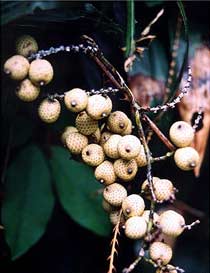 |
|
Fruit of the white rattan |
In tropical and subtropical forests, many large trees are often entwined by a type of “long whip,” known as white rattan, scientifically named Calamus tetradactylus Hance. Typically, white rattan can grow to lengths of 200-300 meters, with some specimens reaching up to 400 meters, making it the longest plant species.
The entire body of the plant is covered with small hooked thorns. The rattan’s tip sways with the wind, brushing against trees; the hooked thorns cling to the trees and never detach. As one side climbs higher, new hooked thorns continue to grow. The plant usually reaches heights of about 100 meters; after climbing to the top, it will turn back down to seek new places to cling until it can grow no more. This results in large trees being adorned with numerous coils of rattan, creating a visually striking scene.
Rattan is a climbing plant belonging to the palm family (Arecaceae), with a very slender stem—only 4-5 cm in diameter—topped with a tuft of feather-like leaves. As new leaves sprout, the old ones fall off, leaving the climbing stem bare.
The rattan stem is very tough and flexible, making it suitable for weaving into furniture, baskets, and various artisanal products. Additionally, rattan is used as a highly effective medicinal herb.


















































